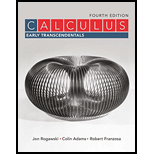
CALCULUS:EARLY TRANS.(LL)-W/ACCESS
4th Edition
ISBN: 9781319308858
Author: Rogawski
Publisher: MAC HIGHER
expand_more
expand_more
format_list_bulleted
Concept explainers
Question
Chapter 17.1, Problem 5PQ
To determine
(a)
Indicate whether the value of each integral is
To determine
(b)
Indicate whether the value of each integral is
To determine
(c)
Indicate whether the value of each integral is
To determine
(d)
Indicate whether the value of each integral is
Expert Solution & Answer
Want to see the full answer?
Check out a sample textbook solution
Students have asked these similar questions
I forgot to mention to you to solve question 1 and 2. Can you solve it using all data that given in the pict i given and can you teach me about that.
exam review please help!
exam review please help!
Chapter 17 Solutions
CALCULUS:EARLY TRANS.(LL)-W/ACCESS
Ch. 17.1 - Prob. 1PQCh. 17.1 - Prob. 2PQCh. 17.1 - Prob. 3PQCh. 17.1 - Prob. 4PQCh. 17.1 - Prob. 5PQCh. 17.1 - Prob. 1ECh. 17.1 - Prob. 2ECh. 17.1 - Prob. 3ECh. 17.1 - Prob. 4ECh. 17.1 - Prob. 5E
Ch. 17.1 - Prob. 6ECh. 17.1 - Prob. 7ECh. 17.1 - Prob. 8ECh. 17.1 - Prob. 9ECh. 17.1 - Prob. 10ECh. 17.1 - Prob. 11ECh. 17.1 - Prob. 12ECh. 17.1 - Prob. 13ECh. 17.1 - Prob. 14ECh. 17.1 - Prob. 15ECh. 17.1 - Prob. 16ECh. 17.1 - Prob. 17ECh. 17.1 - Prob. 18ECh. 17.1 - Prob. 19ECh. 17.1 - Prob. 20ECh. 17.1 - Prob. 21ECh. 17.1 - Prob. 22ECh. 17.1 - Prob. 23ECh. 17.1 - Prob. 24ECh. 17.1 - Prob. 25ECh. 17.1 - Prob. 26ECh. 17.1 - Prob. 27ECh. 17.1 - Prob. 28ECh. 17.1 - Prob. 29ECh. 17.1 - Prob. 30ECh. 17.1 - Prob. 31ECh. 17.1 - Prob. 32ECh. 17.1 - Prob. 33ECh. 17.1 - Prob. 34ECh. 17.1 - Prob. 35ECh. 17.1 - Prob. 36ECh. 17.1 - Prob. 37ECh. 17.1 - Prob. 38ECh. 17.1 - Prob. 39ECh. 17.1 - Prob. 40ECh. 17.1 - Prob. 41ECh. 17.1 - Prob. 42ECh. 17.1 - Prob. 43ECh. 17.1 - Prob. 44ECh. 17.1 - Prob. 45ECh. 17.1 - Prob. 46ECh. 17.1 - Prob. 47ECh. 17.1 - Prob. 48ECh. 17.1 - Prob. 49ECh. 17.1 - Prob. 50ECh. 17.1 - Prob. 51ECh. 17.2 - Prob. 1PQCh. 17.2 - Prob. 2PQCh. 17.2 - Prob. 3PQCh. 17.2 - Prob. 4PQCh. 17.2 - Prob. 5PQCh. 17.2 - Prob. 1ECh. 17.2 - Prob. 2ECh. 17.2 - Prob. 3ECh. 17.2 - Prob. 4ECh. 17.2 - Prob. 5ECh. 17.2 - Prob. 6ECh. 17.2 - Prob. 7ECh. 17.2 - Prob. 8ECh. 17.2 - Prob. 9ECh. 17.2 - Prob. 10ECh. 17.2 - Prob. 11ECh. 17.2 - Prob. 12ECh. 17.2 - Prob. 13ECh. 17.2 - Prob. 14ECh. 17.2 - Prob. 15ECh. 17.2 - Prob. 16ECh. 17.2 - Prob. 17ECh. 17.2 - Prob. 18ECh. 17.2 - Prob. 19ECh. 17.2 - Prob. 20ECh. 17.2 - Prob. 21ECh. 17.2 - Prob. 22ECh. 17.2 - Prob. 23ECh. 17.2 - Prob. 24ECh. 17.2 - Prob. 25ECh. 17.2 - Prob. 26ECh. 17.2 - Prob. 27ECh. 17.2 - Prob. 28ECh. 17.2 - Prob. 29ECh. 17.2 - Prob. 30ECh. 17.2 - Prob. 31ECh. 17.2 - Prob. 32ECh. 17.2 - Prob. 33ECh. 17.2 - Prob. 34ECh. 17.2 - Prob. 35ECh. 17.2 - Prob. 36ECh. 17.2 - Prob. 37ECh. 17.2 - Prob. 38ECh. 17.3 - Prob. 1PQCh. 17.3 - Prob. 2PQCh. 17.3 - Prob. 3PQCh. 17.3 - Prob. 4PQCh. 17.3 - Prob. 5PQCh. 17.3 - Prob. 1ECh. 17.3 - Prob. 2ECh. 17.3 - Prob. 3ECh. 17.3 - Prob. 4ECh. 17.3 - Prob. 5ECh. 17.3 - Prob. 6ECh. 17.3 - Prob. 7ECh. 17.3 - Prob. 8ECh. 17.3 - Prob. 9ECh. 17.3 - Prob. 10ECh. 17.3 - Prob. 11ECh. 17.3 - Prob. 12ECh. 17.3 - Prob. 13ECh. 17.3 - Prob. 14ECh. 17.3 - Prob. 15ECh. 17.3 - Prob. 16ECh. 17.3 - Prob. 17ECh. 17.3 - Prob. 18ECh. 17.3 - Prob. 19ECh. 17.3 - Prob. 20ECh. 17.3 - Prob. 21ECh. 17.3 - Prob. 22ECh. 17.3 - Prob. 23ECh. 17.3 - Prob. 24ECh. 17.3 - Prob. 25ECh. 17.3 - Prob. 26ECh. 17.3 - Prob. 27ECh. 17.3 - Prob. 28ECh. 17.3 - Prob. 29ECh. 17.3 - Prob. 30ECh. 17.3 - Prob. 31ECh. 17.3 - Prob. 32ECh. 17.3 - Prob. 33ECh. 17.3 - Prob. 34ECh. 17.3 - Prob. 35ECh. 17.3 - Prob. 36ECh. 17.3 - Prob. 37ECh. 17.3 - Prob. 38ECh. 17.3 - Prob. 39ECh. 17.3 - Prob. 40ECh. 17.3 - Prob. 41ECh. 17.3 - Prob. 42ECh. 17.3 - Prob. 43ECh. 17.3 - Prob. 44ECh. 17 - Prob. 1CRECh. 17 - Prob. 2CRECh. 17 - Prob. 3CRECh. 17 - Prob. 4CRECh. 17 - Prob. 5CRECh. 17 - Prob. 6CRECh. 17 - Prob. 7CRECh. 17 - Prob. 8CRECh. 17 - Prob. 9CRECh. 17 - Prob. 10CRECh. 17 - Prob. 11CRECh. 17 - Prob. 12CRECh. 17 - Prob. 13CRECh. 17 - Prob. 14CRECh. 17 - Prob. 15CRECh. 17 - Prob. 16CRECh. 17 - Prob. 17CRECh. 17 - Prob. 18CRECh. 17 - Prob. 19CRECh. 17 - Prob. 20CRECh. 17 - Prob. 21CRECh. 17 - Prob. 22CRECh. 17 - Prob. 23CRECh. 17 - Prob. 24CRECh. 17 - Prob. 25CRECh. 17 - Prob. 26CRECh. 17 - Prob. 27CRECh. 17 - Prob. 28CRECh. 17 - Prob. 29CRECh. 17 - Prob. 30CRECh. 17 - Prob. 31CRECh. 17 - Prob. 32CRECh. 17 - Prob. 33CRECh. 17 - Prob. 34CRECh. 17 - Prob. 35CRECh. 17 - Prob. 36CRECh. 17 - Prob. 37CRECh. 17 - Prob. 38CRECh. 17 - Prob. 39CRECh. 17 - Prob. 40CRECh. 17 - Prob. 41CRE
Knowledge Booster
Learn more about
Need a deep-dive on the concept behind this application? Look no further. Learn more about this topic, calculus and related others by exploring similar questions and additional content below.Similar questions
arrow_back_ios
SEE MORE QUESTIONS
arrow_forward_ios
Recommended textbooks for you
 Glencoe Algebra 1, Student Edition, 9780079039897...AlgebraISBN:9780079039897Author:CarterPublisher:McGraw Hill
Glencoe Algebra 1, Student Edition, 9780079039897...AlgebraISBN:9780079039897Author:CarterPublisher:McGraw Hill

Glencoe Algebra 1, Student Edition, 9780079039897...
Algebra
ISBN:9780079039897
Author:Carter
Publisher:McGraw Hill
Definite Integral Calculus Examples, Integration - Basic Introduction, Practice Problems; Author: The Organic Chemistry Tutor;https://www.youtube.com/watch?v=rCWOdfQ3cwQ;License: Standard YouTube License, CC-BY